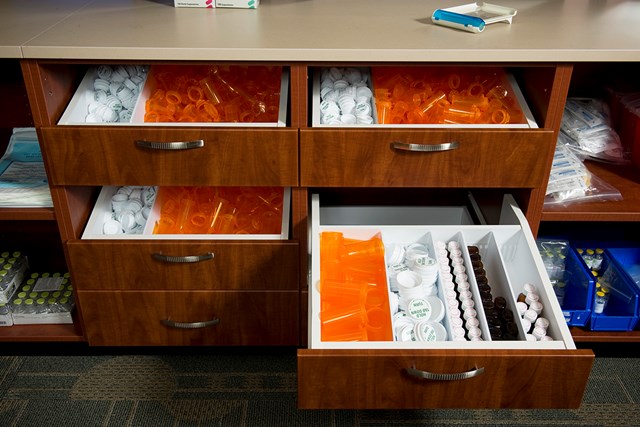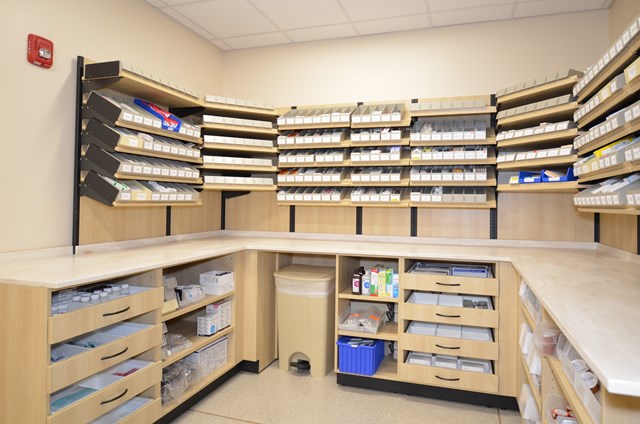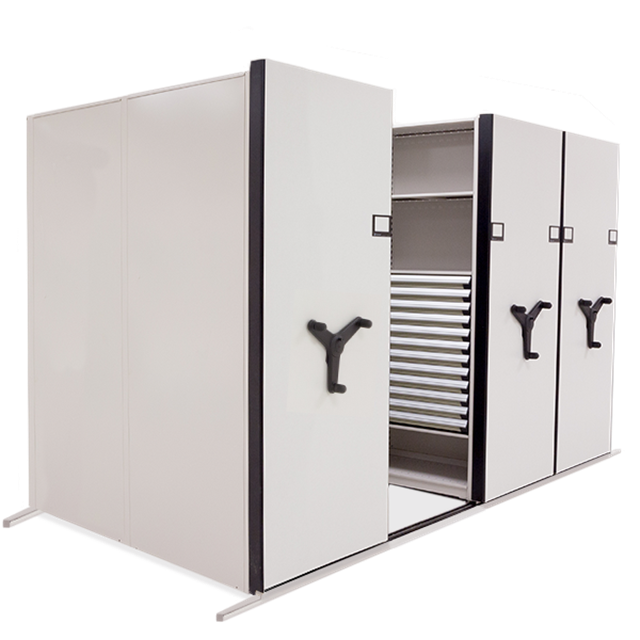
Storage Solutions Based on Workflow in the Central Pharmacy
Things to Consider When Choosing Pharmacy Storage
When speaking with our customers about their pharmacy’s requirements, the response often is “I need more storage”.
Pharmacies are looking for new storage solutions to assist with the influx of medication demands. The key is to maximize storage space while improving workflow and ensuring all USP and state regulations are met.
Work smarter, not harder can easily be applied to designing storage systems in a central pharmacy. The goal is to choose solutions that provide space to organize materials and assist in improving workflow. Below are some tricks of the trade that allow for additional storage space without interrupting pharmacy workflow.
Undercounter Storage
There is some difference of opinion over whether drawers or shelves are better in base cabinets. Some prefer shelves to avoid the inevitable “junk drawer” problem, while others prefer drawers with dividers to better organize materials and allow for easier access to the whole space.
Narcotics Storage
In the past, narcotics were usually stored in a walk-in safe. Due to an update in security measures and requirements, some pharmacies have changed their narcotic storage to be locking cabinets or automated drug cabinets (ADM). Note, while it provides several benefits, ADMs can result in more requirements placed on the pharmacy by regulations. Narcotic cabinets can be core-removable or push-button/electronic locks. Storing narcotics in locking cabinets tends to provide easier access for employees and improves workflow.
Pick Station
Workflow efficiency is crucial when working at a pick station – otherwise, you can end up with a traffic jam at the picking counter. The key is to design a station that can handle the volume of medication storage needed while making med selection efficient for the staff. All medications should be easily accessible which is why many pharmacies use over-counter gravity-fed shelves for storage. Gravity-fed shelving allows for ease of view and use, eliminating the need for step stools; medications will always be in the front of the shelf. This cuts down on time wasted searching for the correct medicine.
Packaging Area
The packaging area of a pharmacy may vary based on the footprint of the repackaging machine and the number of doses packaged per day. For example, if using a tabletop packager consideration might be given to the height of the counter. Many tabletop packagers are top-loading, whereby the pharmacy tech needs to be able to see into the top of the machine without difficulty.
In addition to the height of the counter, counter space is something to consider. The countertop needs to have space to house the packager, monitor, and a small workstation. It is also helpful to have a couple of drawers nearby for the storage of packager tools and supplies.
Bulk Storage
Every pharmacy needs bulk storage space. Some things to consider are cost, space, and ease of access. If you are looking for a cost-effective solution that allows for easy reconfiguration, then stationary storage might be the bulk storage solution for you. Even though stationary storage takes up a lot of space, it does allow for ease of access to all medications.
To get the most storage for your space, consider a high-density mobile storage system. This type of storage maximizes shelving in a smaller footprint. It may prove to be more convenient to store all commonly used medications on one aisle and leave the storage unit open to those shelves for quick access. To learn more about space optimization using mobile storage in a central pharmacy, visit our blog post on the Magic of Mobile Storage.
If you found this article useful, check out our previous blog Storage Solutions Based on Workflow in the Outpatient Pharmacy.


